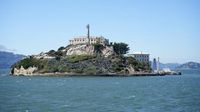On May 4, 2025, President Donald Trump announced plans to reopen and expand the infamous Alcatraz Federal Penitentiary, a move that has stirred a mix of nostalgia and controversy across the United States. In a post on his Truth Social platform, Trump proclaimed, "REBUILD, AND OPEN ALCATRAZ! For too long, America has been plagued by vicious, violent, and repeat Criminal Offenders, the dregs of society, who will never contribute anything other than Misery and Suffering." He directed several federal agencies, including the Bureau of Prisons, the Department of Justice, and the FBI, to develop plans for a "substantially enlarged and rebuilt" facility intended to house the country’s most dangerous criminals.
Alcatraz, located on an island in San Francisco Bay, is currently a popular tourist attraction, drawing visitors eager to learn about its storied past. Originally, the island served as a military fortification during the Civil War, housing Confederate prisoners and later evolving into a military prison by 1907. In 1934, it was converted into a federal penitentiary, gaining notoriety for housing some of the most infamous criminals in American history, including Al Capone, George “Machine Gun” Kelly, and Robert Stroud, the so-called "Birdman of Alcatraz."
During its nearly three-decade run as a federal prison, Alcatraz housed over 1,500 inmates. The prison was renowned for its high security and harsh conditions, which contributed to its reputation as an inescapable fortress. However, on June 12, 1962, three prisoners—Frank Lee Morris and brothers John and Clarence Anglin—managed to escape in what became one of the most famous prison breaks in history.
According to the BBC, Morris, who had been transferred to Alcatraz in January 1960 after escaping from Louisiana State Penitentiary, devised a meticulous escape plan. Morris, along with the Anglin brothers and fellow inmate Allen West, spent months digging through the walls of their cells using metal spoons stolen from the cafeteria. They carved out a path to a utility corridor, where they constructed a makeshift raft out of stolen raincoats and life jackets.
On the night of June 11, 1962, the trio put their plan into action. They left behind dummy heads made of soap, paper, and hair to trick the guards into thinking they were asleep. After climbing to the roof and descending through a drainage pipe, they inflated their raft and disappeared into the waters of the bay. The alarm was raised the next morning when guards discovered the ruse. A massive manhunt ensued, but the three men were never found.
In the days following their escape, the Coast Guard recovered some of their belongings, including a makeshift paddle and a life jacket, but the fate of Morris and the Anglins remains a mystery. In 1979, they were declared legally dead, but speculation about their survival continued, fueled by alleged sightings and mysterious letters claiming to be from one of the fugitives.
Trump’s recent announcement has reignited interest in the prison's legacy, as well as discussions about crime and punishment in America. Former FBI special agent Jonathan Gilliam suggested that a prison model similar to Alcatraz could be more effective if built on San Clemente Island, away from the mainland. He believes that a new facility could serve as a deterrent for violent offenders.
The original Alcatraz prison was closed in 1963, largely due to its deteriorating infrastructure and high operational costs, which were estimated at around $40,000 per prisoner annually. The remote location made it difficult to transport supplies, and the prison faced increasing criticism for its harsh conditions and inability to rehabilitate inmates.
After its closure, Alcatraz became a symbol of resistance and a site of historical significance. In 1969, a group of Native American activists occupied the island for 19 months, claiming it as their own and drawing attention to the injustices faced by indigenous peoples. This occupation was pivotal in changing public perception about the island, leading to its designation as a National Historic Landmark in 1986.
As discussions about reopening Alcatraz unfold, questions arise about the implications for modern criminal justice. Supporters of the plan argue it could provide a solution to the growing problem of violent crime, while critics warn against the potential for inhumane treatment and the failure of prisons to rehabilitate offenders.
Al Capone, one of Alcatraz's most notorious inmates, was sentenced to 11 years for tax evasion and was transferred to the island in 1934 after allegations of preferential treatment in other prisons. He was released for good behavior in 1939 but spent his final years suffering from syphilis and mental decline. Similarly, George Kelly, known as "Machine Gun" Kelly, was imprisoned at Alcatraz from 1934 to 1951 after a high-profile kidnapping. Robert Stroud, who became famous for his study of birds while incarcerated, spent 17 years at Alcatraz before his death in 1963.
As the debate surrounding Trump's proposal continues, the legacy of Alcatraz remains a complex tapestry of crime, punishment, and the quest for justice in America. The prison's history serves as a reminder of the challenges and failures of the penal system, as well as the ongoing struggle for reform. Whether or not Alcatraz will reopen is uncertain, but its story, entwined with the narratives of its infamous inmates, continues to captivate the public's imagination.




